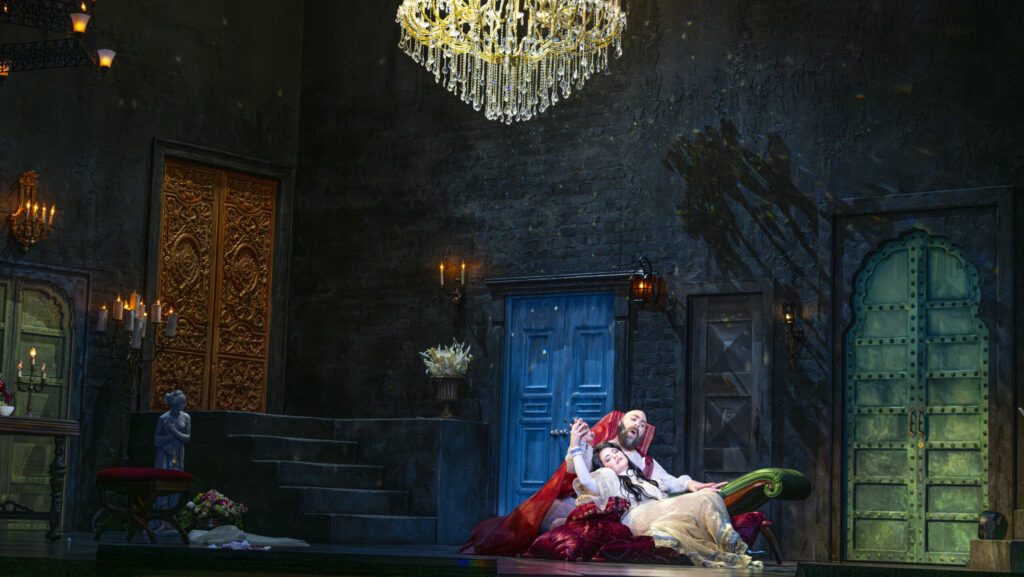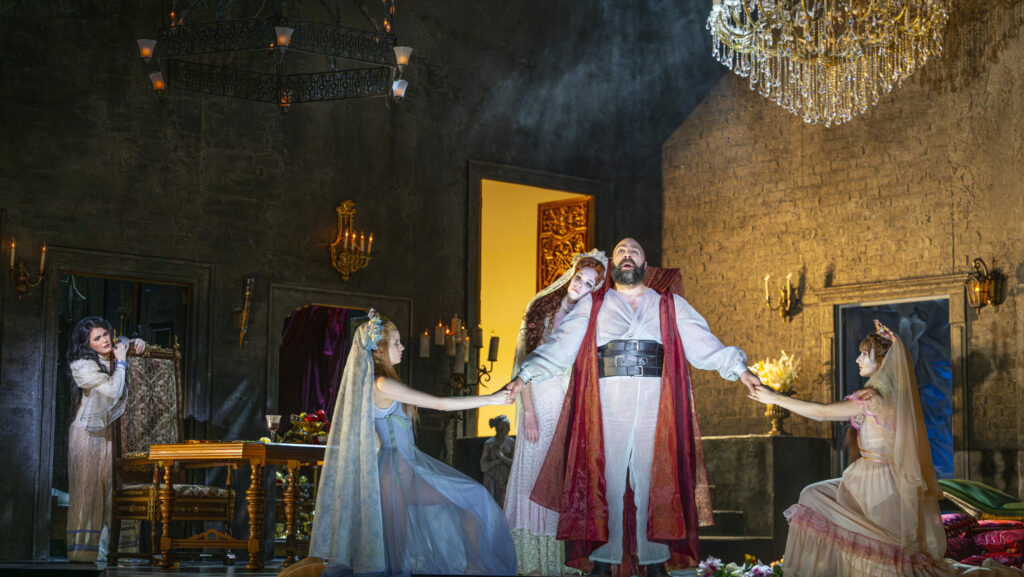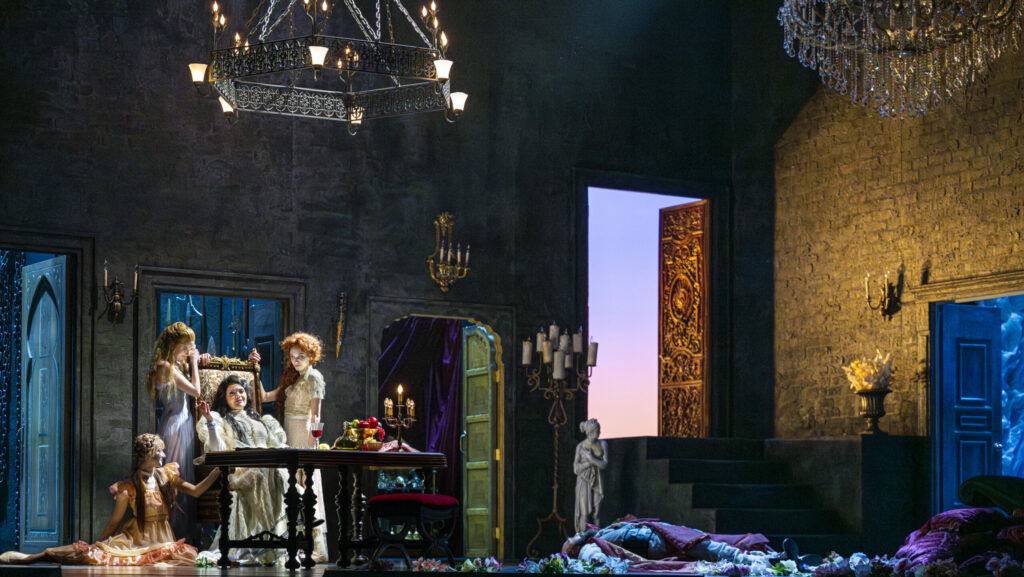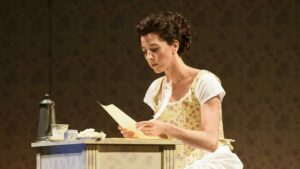
David Allen
The lavish production, directed by OSJ General Director and CEO Shawna Lucey and vigorously conducted by OSJ Music Director Joseph Marcheso, is sung in English with a new English translation by Steven White and Marcheso, plus supertitles in English and Spanish. It opened at the California Theatre on Saturday, February 15th, and was seen last Friday.
But first, I think it is worth addressing the big elephant in the room: its run time. At roughly 70 minutes, Bluebeard’s Castle is usually paired with another one-act opera. (For example, the only two times San Francisco Opera presented the opera, it was paired with Maurice Ravel’s L’heure espagnole.) OSJ’s decision to produce this particular opera on its own may have had something to do with the many empty seats in the auditorium last Friday. It was a pity, though, because the stunning production, performed by its fully committed cast, definitely made an excellent showcase for the opera and deserves to be seen more widely!
Bartók composed Bluebeard’s Castle, his sole opera, in 1911. Seven years later, it was first performed at the Royal Hungarian Opera House. Balázs’s libretto was based on a French folk legend as told by Charles Perrault. There are only two leading roles in the opera, Bluebeard and Judith. (Bartók himself considered the Castle the third character.) Bluebeard and Judith have just eloped, and Bluebeard is bringing her to his castle, which is entirely dark. The Castle has seven doors, and Judith insists that all doors be opened to allow light. Bluebeard refuses and tells Judith to love him but asks no questions. Judith persists and eventually prevails over his resistance, rolling the story into its concluding dire consequences.

David Allen
Chockful of symbolism, Bluebeard’s Castle (just like its folktale source) allows various interpretations of the story. While Perrault used the fable to preach obedience to wives, other scholars, including folklorist Maria Tatar in her The Annotated Classic Fairy Tales, suggested that it encourages women not to follow patriarchal rules unquestioningly. The latter seemed to color OSJ’s production of Bluebeard’s Castle, as Lucey offered a feminist look at the opera in her staging. This Judith-centric concept was nothing new in itself; in 2020, Katie Mithell transformed the opera (combined with Bartók’s own Concerto for Orchestra) into a new work called Judith, where she was a police detective in search of a serial killer (aka Bluebeard), for the Bayerische Staatsoper.
Lucey, however, was much more subtle in her handling of the story. Instead of changing the setting à la Mitchell, she stayed within the confines of Bartók and Balázs’s realm while changing the power dynamics between the two genders. In her richly detailed Director’s Note, she explained that “Judith’s insistence on unlocking the castle’s secrets is both a radical and defiant act. In a world that has long demanded women accept half-truths and silence, Judith’s refusal to stop at Bluebeard’s warnings becomes a feminist assertion of autonomy. Her desire to see and understand is not an invasion; it is a reclamation of the right to confront the truths that have been deliberately hidden. In this context, Judith is not simply a lover; she is a disruptor of patriarchal norms, challenging the very foundations of Bluebeard’s power.”
Lucey gracefully implemented her vision above by presenting both characters as having equal stature. She meticulously painted their interactions in well-choreographed movements as if they were dances. A large push-pull between the two roles created an unbelievable tension sustained throughout the opera. Bluebeard’s repeated, playful “Frightened?” phrases, in fact, brought to mind another French folktale — Beauty and the Beast — in his eagerness to please his new lover. Suffice it to say, Lucey had surprises waiting in store at the end that entirely supported her point of view!
https://www.youtube.com/watch?v=3L0C8_L9PDE
Lucey assembled a great creative team for this production, and it showed. Set designer Steven C. Kemp placed the action inside a Gothic castle adorned by multiple chandeliers and furniture. As shown below, the first three doors were located at stage left, the following three on stage right, and the last door in the center following some steps. They were all different shapes, sizes, and colors, reminiscent of past OSJ productions.
If I may nitpick, Lucey (and Kemp) seemed to favor angled backdrop set pieces (similar to the set pieces of her Tosca. The issue was that each time a door opened, the décor indicated the room was placed far behind that narrow door, only visible to those sitting in the middle section of the auditorium. I was sitting on the aisle of the house right, and yet, I still couldn’t see any insides of doors 4 – 6. Luckily, Michael James Clark’s extraordinary lighting gave an adequate description of the contents of those doors, particularly on the climactic door 5.
His work on door 5 was genuinely excellent; it started with bright white light through the tiny door, and when Bluebeard described the vast kingdom, it shifted towards the front center as if Bluebeard was addressing his kingdom! Similarly, Clark turned the lighting color for door 6 to blue (the actual color of the door), and when it opened, he modulated the lighting as if it was underwater! Caitlin Cisek dressed both characters in white, although I loved that Bluebeard had a winged red cape. (Her clever pun on “red flag,” I assumed.)

David Allen
Nevertheless, the greatest strength of OSJ’s Bluebeard Castle lay with the two principal singers who gave their all to embody Bluebeard and Judith, namely baritone Zachary Nelson and Italian-American soprano Maria Natale (a previous OSJ’s artist in residence), both of which were making role debuts. It was exhilarating to watch the career progression of Nelson – a replacement for the first announced bass-baritone Jason Zacher – ever since I caught him stealing the limelight as Sancho in the Philadelphia Academy of Vocal Arts’s production of Jules Massenet’s Don Quichotte in 2013.
With a deep, booming voice and a commanding presence, Nelson let you understand the inner thoughts of Bluebeard, from the coy demeanor to please Judith to the resignation of losing his secret life. His diction was admirably commendable, making full use of White and Marcheso’s words (even without the need for the supertitles), particularly in the oft-omitted “Prologue of the Bard,” delivered with the deliberate intention to make the audience pay attention to the moral of the story (which can be applied to real-life as well to Bluebeard and Judith). There was nothing remotely sad or demonic in Nelson’s Bluebeard, a fact that Nelson alluded to in the interview below. If anything, he fully embraced the debonair loverboy aspect of his character, who finally more than met his match this time!
https://youtu.be/4a6vMXri7MM?si=qFhhG2ZVRvUx-iGY
Nelson established great chemistry with Natale, who embodied Judith with chameleon-like behavior. A proper stage animal, Natale moved from giddy excitement to seduction to nagging presence to terror with ease, quickly grabbing your attention throughout the opera. Similarly, she intelligently employed her considerably large instrument, paying full attention to Bartók’s highly chromatic and speech-inflected vocal lines. She indeed rose to the occasion at the climactic door 5, riding the orchestra while blaring high C to the auditorium and kneeling next to Bluebeard. Another significant aspect of her Judith personification was her graceful movements, particularly during the sixth-door scene. Natale performed almost a delirious dance, suggesting the water of “a lake of tears” flowing through her, and it was truly fascinating to watch!
In the Conductor’s Note, Marcheso admitted that “[i]t is an honor to be able to promote music that you believe in,” and his conviction in the power of Bartók’s score shone through in the way he conducted the 40-plus member Orchestra. Not only did he bring a reading full of vigor and splendor, but more importantly, he highlighted the central role of the Orchestra in depicting the third character, the Castle. In his hands, the Castle came alive, and each door was presented with an altogether different point of view that was absolutely fascinating. You could almost hear the metals in the torture chamber’s first door, see the gleaming gold and diamonds with their implications of greed in the third door, smell the flowers beneath the fourth door, and get swept away with the flood of tears in the sixth door. In the loud, chorale-like fifth door, you couldn’t help feeling on top of the world, facing Bluebeard’s kingdom! Marcheso’s power of persuasion was fully on exhibit that day, and it was indeed a great asset to ensure the success of this show!
There are only two performances left in this run, and you can decide for yourself whether this is an endeavor you are willing to take, given the short running time. Personally, the answer is a resounding YES, as an intelligent performance of Bartók’s masterpiece, performed with such loving trust and conviction, is indeed hard to find!





Comments